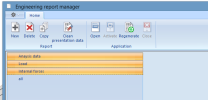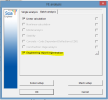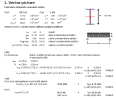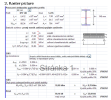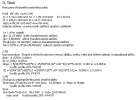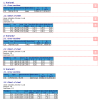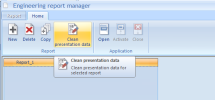Tips and tricks
This chapter describes useful features of Engineering Report which can help to improve efficiency of preparation of reports.
Automatic joining of several reports using regeneration during batch analysis and items External report
Since version 14.1 it is possible to automatically regenerate and exports selected reports at the end of Batch analysis. Since this version it is also possible to insert references to files with exported content of reports into Engineering report. Those two new features together enables automatically joint several reports and export them all into one PDF file with one common table of contents and common numbering of pages and chapters.
In the example there are three reports (Analysis data, Load definition and Internal forces).
All those three reports have selected to be exported into *.dds file after external regeneration (regeneration started from batch analysis)
The fourth report called "all" contains items External reports linked to particular *.dds files specified in setting for export after regeneration (previous point).
The export after regeneration for this fourth report is set to the PDF file with automatic opening of the PDF.
In the setting of batch analysis there is selected regeneration of all reports.
This setting ensures that at the end of batch analysis the first 3 reports are regenerated and exported into *.dds files. Those *.dds files are then loaded into the fourth report. Finally this fourth report is exported into PDF file.
Inserting calculations from external programs
Doing of supplementary calculation in other programs (e.g. Excel, MathCad, Word ...) is very common case. The Engineering Report enables very easy way of inserting of those calculations using windows clipboard (Copy - Paste). Some programs stores its data into clipboard in more formats. Engineering Report enables to insert (paste) them as plain text, raster picture and vector picture.
Vector and raster pictures are inserted as report item External picture. Texts are inserted as report item "Formatted text" and can be then formatted using formatted text editor.
The following chapters are meant as an example of common programs. The windows clipboard is supported by majority of programs and can be used for inserting of their data into Engineering Report.
Note: The size of external picture (also external pictures inserted by Paste function) is defined by Height and Width property. It is possible to set one size to 0. In such case the size is calculated automatically from the aspect ratio of the picture.
Inserting from Microsoft Excel
Microsoft Excel stores data in the clipboard in all three formats supported by Engineering Report. Each format provides different output.
- Vector picture looks like printed output from Excel.
- Raster picture looks like a screen shot of the Excel sheet.
- Plain text insert only text content of Excel cells.
Some version of Excel does not provide the vector picture.
Inserting from Microsoft Word
From the formats which the Microsoft Word use s for clipboard the Engineering Report can use a vector picture or a text.
- Vector picture looks like printed output from the Word document. It contains formatted text, pictures, formulas...
- Plain text contain only text content from the document. It is inserted as Formatted text report item and can be then formatted using Formatted text editor.
Inserting from MathCad
The MathCad stores its data into clipboard as a raster picture or vector picture. Both of them looks similar while the vector picture is sharper and use less memory.
Inserting from PDF files
There can be multiple types of PDF viewers but the most common one is Adobe Reader. The Adobe Reader stores the data into clipboard as a text or picture. It depends on the type of PDF. The text usually contains a lot of special characters which are not correctly displayed in Engineering Report. It is usually better to do the screen shot of PDF preview and insert it as a picture.
Inserting drawings from Autocad
Sometimes it is necessary to insert drawings into the structural report. Using of Autocad is quite common and therefore this chapter describes the way of inserting of drawing from Autocad. Inserting of drawings from other CAD software can be similar.
There are several possibilities how to do it:
- Drawing can be printed as a *.jpg or *.png picture. This is enabled by the Autocad itself. Then such picture can be inserted in Engineering Report as an external picture (see also chapter External picture as an external reference) or via clipboard.
- *.dwg file can be inserted directly as External picture.
- It is possible to use Copy - Paste from the Autocad to Engineering Report.
Following chapters will summarize positives and negatives of those variants.
Printing drawings into *.jpg or *.png
Positives:
- pictures can be inserted as "external reference" (their changes can be respected in Engineering Report using Regenerate function)
- pictures respect line thickness and colour setting used in Autocad for printing
- there can be generated more drawings from one *.dwg (it is possible to print to picture just specific part of *.dwg)
Negatives:
- not very easy to define correct picture size and scale
- pictures are stored as raster images, their quality is lower
Inserting *.dwg as an External picture
Positives:
- pictures can be inserted as "external reference" (their changes can be respected in Engineering Report using Regenerate function)
- it is not necessary to have Autocad installed
- pictures are printed as vector ones and thus have high quality
- since version 14 it is possible to change the view point and the zoom (display only wanted part of the drawing)
- since the version 14.1 it is possible to automatically convert colours into various thickness of lines
Negatives:
- pictures do not respect line thickness and colour setting used in Autocad for printing (*.ctb or *.stb)
- since the version 14.1 it is possible to convert colours of lines into different line thickness in similar way as in AutoCAD, therefore the negative is not valid any more
Engineering Report supports inserting of *.dwg up to version Autocad 2011.
Copy - Paste from Autocad to Engineering Report
The result of Copy - Paste depends on position in Autocad where the Copy function is called. When the copy is done in "Model" the current colours and line thickness are used. When the copy is done inside the "Layout view" (but model editing mode) the colours and line thickness are according to selected printing style.
Positives:
- pictures can respect line thickness and colour setting according to selected printing style
- pictures are printed as vector ones and thus have high quality
- there can be generated more drawings from one *.dwg (it is possible to Copy just specific part of *.dwg)
Negatives:
- pictures cannot be inserted as "external reference" - after any change in *.dwg it is necessary to insert the picture again
Autocad - "Model view"
Autocad "Layout view"
Autocad layout view - drawing selected
Pasted into Engineering Report
External pictures as an external references
The report item External picture supports two ways of storing the picture definition. The first possibility is use Embedded picture which means the picture is stored together with the *.esa project. The second possibility is to insert picture just as an external reference (Embedded picture is switched OFF).
When the picture is inserted as an external reference it is not stored with the *.esa file so its size does not increase. The source picture file on the hard drive is continuously checked and user is notified about its change by validity status (External picture item is marked as invalid).
Regeneration of the picture reread its content from hard drive and makes it content again valid.
In this way it is possible to work with external pictures in similar way as with e.g. XRefs in AutoCad.
Fast picture preview
The most time demanding operation needed for displaying of a report picture is its OpenGL rendering. On weaker computers the OpenGL rendering can take several seconds in case of bigger pictures. There are two possibilities how to skip the rendering procedure:
- set the value of picture property Rendering to "Wired" - Wired pictures does not need to be rendered. On the other hand in Wired pictures it is not possible to display surfaces.
- keep the value of property Rendering on "Rendered by OpenGL" and switch on the Fast picture preview on ribbon View
The second mentioned possibility (Fast picture preview) ensures that all pictures in the report are displayed as wired in the report preview but printed and exported are according to the property Rendering. It means that the rendering process is done only during printing or export to PDF or Html. This will increase the speed of redrawing of rendered pictures e.g. after opening of report or after editing of pictures.
The Fast picture preview is respected in the document preview in the Report manager. It is also respected in the print preview but it is ignored in printing and export.
It is recommended to have the Fast picture preview switched ON during report preparation and then switch it OFF before printing to check that all desired pictures will be rendered.
Fast table preview
In case of having long tables manipulations with report items can become slower. To enable faster editing of report content it is possible to switch ON the Fast table preview.
It results in cutting of tables when only two first rows are displayed and information text is added.
This setting is also ignored during export and printing. It means that whole tables are always printed and exported regardless on the Fast table preview status.
The speed of drawing of tables can be increased by switching OFF the automatic calculation of table column width. This can be done in the Table layout editor (see the related chapter).
Having results from more variants of the model in one report
One of biggest benefits of Engineering Report is keeping of presentation data and possibility to lock part of the report. Besides common benefits such as immediate visible content of report after its opening, predictable regenerations and overall stability it enables also creating of more advanced report describing different versions of one model.
Preparation of such report is very easy. Just calculate the current version of the model, create part of a report with output from this version of the model. Make sure that all tables in this part are regenerated and lock them. Then modify the model (create a new variant) and Copy - Paste the part describing the first variant to new chapter and regenerate it. Then you can have information about the first variant in the first chapter and information about the second variant in the second chapter.
Navigator with 3 variants:
Example of output:
Copy - Paste between reports
It is possible to move or copy report items between different reports using the windows Clipboard (Copy - Paste). This function enables to copy all report items (except the Gallery pictures) between various reports even between reports from different projects. During Copy - Paste are also copied all properties of selected report items and also other definition data (definition of Style or Header / Footer).
Using this Copy - Paste it is easily possible to copy structure of one report to another report in another project.
Reducing size of *.esa file by cleaning report presentation data
The basic idea of Engineering Report is to store as many data as possible to make the report stable and prevent not necessary regenerations to the minimum. Therefore all data which are once obtained in regeneration are stored on hard drive and kept in *.esa file. Usually it is not a problem but especially if it is necessary to send the project via e.g. email, the size of the project (*.esa file) is more important that time needed for regeneration of the report.
For such cases it is possible to Clean presentation data of reports in Engineering Report manager.
This function removes all data which are not necessary for future regeneration of the report. It does not delete e.g. embedded external pictures neither Screen shot pictures from SCIA Engineer.
It is possible to significantly reduce the size of *.esa file using this function.

